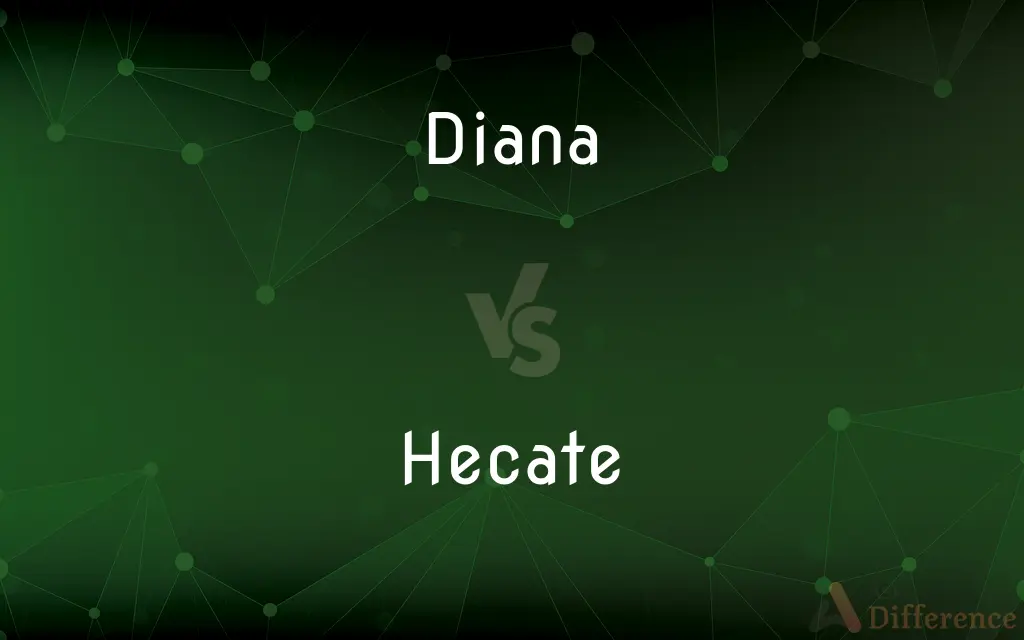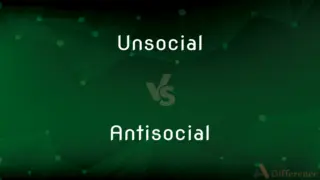Diana vs. Hecate — What's the Difference?
Edited by Tayyaba Rehman — By Maham Liaqat — Updated on April 5, 2024
Diana is primarily known as the Roman goddess of the hunt, forests, and childbirth, symbolizing purity and chastity, whereas Hecate is the Greek goddess associated with magic, crossroads, and ghosts, often considered more mysterious and darker.

Difference Between Diana and Hecate
Table of Contents
ADVERTISEMENT
Key Differences
Diana holds a position in Roman mythology as the virgin goddess of the hunt and nature, embodying the aspects of fertility and protection of the wild. On the other hand, Hecate’s domain in Greek mythology extends into the more arcane realms of magic, witchcraft, and the night, representing a guide for souls to the underworld.
While Diana is celebrated for her connection to animals and woodland, her mythology often emphasizes her role in protecting the forest and its creatures. Hecate, conversely, is revered for her knowledge and power over the supernatural, including ghosts and protective magic, marking her as a deity of the boundaries between worlds.
Diana’s worship included ceremonies and rituals in natural settings, reflecting her role as guardian of the wilderness and patron of women in childbirth. Whereas Hecate’s followers often performed their rites at crossroads or used spells, invoking her power for protection or to harness her influence over the unknown.
In art and literature, Diana is frequently depicted with a bow and arrows, accompanied by a deer or hunting dogs, symbolizing her mastery over hunting and her purity. Hecate, in contrast, is often shown holding torches or keys, and sometimes with three faces or bodies, symbolizing her power over crossroads and her visibility into past, present, and future.
Both goddesses exhibit aspects of femininity and power, but Diana’s portrayal leans towards the nurturing and light, focusing on life and nature’s cycles. Hecate’s representation, however, delves into the mystical and darker aspects of female divinity, encompassing death, rebirth, and the unseen.
ADVERTISEMENT
Comparison Chart
Domain
Hunt, forests, childbirth
Magic, crossroads, underworld
Symbolism
Purity, protection, fertility
Mystery, magic, transformation
Worship Practices
Ceremonies in natural settings, rituals for childbirth and protection
Rites at crossroads, magic and protective spells
Artistic Depictions
Bow and arrows, deer, hunting dogs
Torches, keys, three faces/bodies
Influence on Followers
Guidance in nature and protection of women
Protection, guidance in magic and the supernatural
Compare with Definitions
Diana
Roman goddess of the hunt and nature.
In ancient times, Romans prayed to Diana for success in hunting and protection in the wild.
Hecate
Greek goddess of magic, witchcraft, and the night.
Hecate was called upon for her knowledge of magic and the occult.
Diana
Guardian of women in childbirth.
Many invoked Diana for her blessing on women during childbirth.
Hecate
Patroness of crossroads and transitions.
Ancient Greeks left offerings at crossroads to honor Hecate's guidance at life's intersections.
Diana
Associated with the moon.
Diana was also identified with the moon, marking her as a luminary in the night sky.
Hecate
Emblem of mystery and the supernatural.
Hecate’s power was sought in rituals aiming to uncover hidden truths or foretell the future.
Diana
Symbol of purity and chastity.
Diana was revered as a virgin goddess, embodying ideals of purity.
Hecate
Symbolized by torches and keys.
Depictions of Hecate often include torches to light the way through darkness and keys to unlock secrets.
Diana
Protector of animals and the forest.
Followers of Diana often celebrated her connection to wildlife and natural landscapes.
Hecate
Associated with ghosts and the underworld.
Hecate's connection to the underworld made her a mediator between the living and the dead.
Diana
The virgin goddess of hunting and childbirth, associated with the moon and identified with the Greek Artemis.
Hecate
Hecate or Hekate is a goddess in ancient Greek religion and mythology, most often shown holding a pair of torches, a key, snakes or accompanied by dogs and in later periods depicted in triple form. She is variously associated with crossroads, entrance-ways, night, light, magic, witchcraft, knowledge of herbs and poisonous plants, ghosts, necromancy, and sorcery.
Diana
The daughter of Jupiter and Latona; a virgin goddess who presided over hunting, chastity, and marriage; - identified with the Greek goddess Artemis.
And chaste Diana haunts the forest shade.
Hecate
An ancient fertility goddess who later became associated with Persephone as queen of Hades and protector of witches.
Diana
English aristocrat who was the first wife of Prince Charles; her death in an automobile accident in Paris produced intense national mourning (1961-1997)
Hecate
(Greek mythology) Greek goddess of fertility who later became associated with Persephone as goddess of the underworld and protector of witches
Diana
(Roman mythology) virgin goddess of the hunt and the moon; counterpart of Greek Artemis
Common Curiosities
What does Hecate represent?
Hecate represents magic, crossroads, and the underworld in Greek mythology, often associated with witchcraft and the supernatural.
What are Hecate’s symbols?
Hecate is often symbolized by torches, keys, and sometimes three faces or bodies, indicating her power over magic and the crossroads.
How were Diana and Hecate worshipped?
Diana’s followers conducted ceremonies in nature and rites for protection and fertility, while Hecate’s were known for rituals at crossroads and using magic.
What are the symbols associated with Diana?
Diana is symbolized by the bow and arrows, deer, and hunting dogs, reflecting her dominion over hunting and the wilderness.
Who is Diana in Roman mythology?
Diana is the Roman goddess of the hunt, forests, and childbirth, known for her purity and protection of the wild.
Why is Hecate associated with crossroads?
Hecate is associated with crossroads as they symbolize choices, transitions, and her ability to see into past, present, and future.
What distinguishes Diana’s followers from Hecate’s?
Diana’s followers focused on nature and protection rites, whereas Hecate’s were more involved with magic and the occult.
How do depictions of Diana and Hecate differ in art?
Diana is often depicted in a huntress’s attire with animals, while Hecate may appear with attributes like torches or in a triple form.
What is the significance of Hecate’s torches?
The torches symbolize enlightenment, guidance through darkness, and her ability to navigate through uncertainty.
Can Diana and Hecate be compared?
Yes, while Diana and Hecate come from different mythologies, they can be compared in terms of domains, symbols, and worship practices.
What role did Diana play for women?
Diana was seen as a protector and guardian of women, especially during childbirth.
Were Diana and Hecate ever merged in mythology?
In later traditions, aspects of these goddesses were sometimes syncretized or merged, reflecting overlapping domains like protection and the night.
Is there a connection between Diana and the moon?
Yes, Diana was also associated with the moon, embodying its illuminating and protective qualities.
How did ancient societies view Diana and Hecate?
Diana was viewed as a benevolent goddess of light and life, while Hecate was often seen with ambivalence, respected for her power but also feared.
What lessons can we learn from Diana and Hecate?
From Diana, the importance of conservation and respect for nature; from Hecate, the understanding of transitions and the unseen forces in life.
Share Your Discovery

Previous Comparison
Unsocial vs. Antisocial
Next Comparison
Semasiology vs. OnomasiologyAuthor Spotlight
Written by
Maham LiaqatEdited by
Tayyaba RehmanTayyaba Rehman is a distinguished writer, currently serving as a primary contributor to askdifference.com. As a researcher in semantics and etymology, Tayyaba's passion for the complexity of languages and their distinctions has found a perfect home on the platform. Tayyaba delves into the intricacies of language, distinguishing between commonly confused words and phrases, thereby providing clarity for readers worldwide.















































